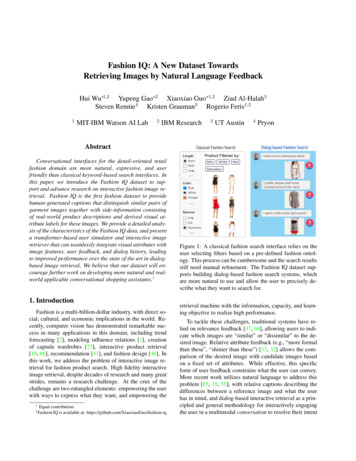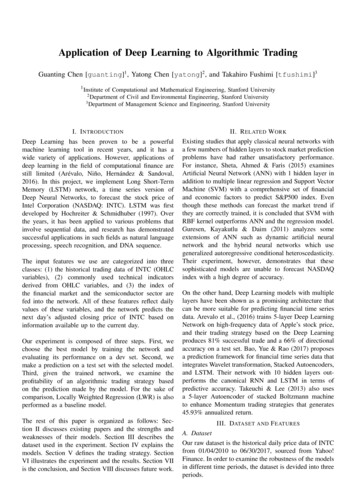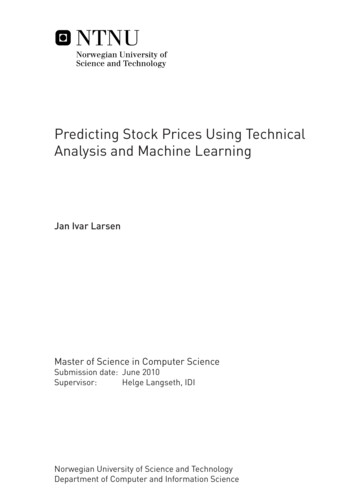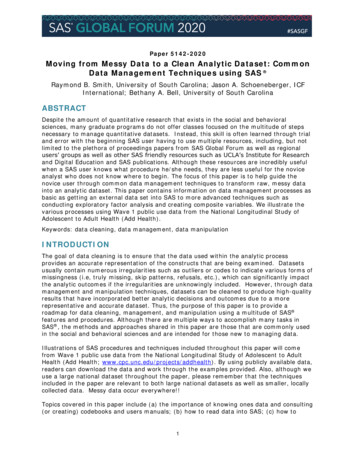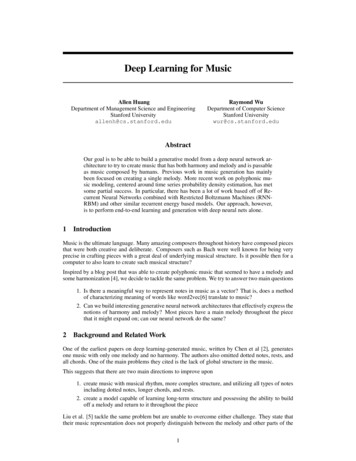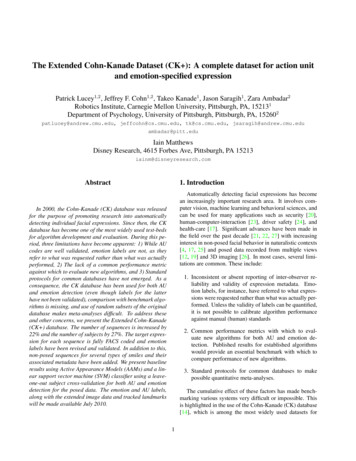
Transcription
The Extended Cohn-Kanade Dataset (CK ): A complete dataset for action unitand emotion-specified expressionPatrick Lucey1,2 , Jeffrey F. Cohn1,2 , Takeo Kanade1 , Jason Saragih1 , Zara Ambadar2Robotics Institute, Carnegie Mellon University, Pittsburgh, PA, 152131Department of Psychology, University of Pittsburgh, Pittsburgh, PA, 152602patlucey@andrew.cmu.edu, jeffcohn@cs.cmu.edu, tk@cs.cmu.edu, jsaragih@andrew.cmu.eduambadar@pitt.eduIain MatthewsDisney Research, 4615 Forbes Ave, Pittsburgh, PA 15213iainm@disneyresearch.com1. IntroductionAbstractAutomatically detecting facial expressions has becomean increasingly important research area. It involves computer vision, machine learning and behavioral sciences, andcan be used for many applications such as security [20],human-computer-interaction [23], driver safety [24], andhealth-care [17]. Significant advances have been made inthe field over the past decade [21, 22, 27] with increasinginterest in non-posed facial behavior in naturalistic contexts[4, 17, 25] and posed data recorded from multiple views[12, 19] and 3D imaging [26]. In most cases, several limitations are common. These include:In 2000, the Cohn-Kanade (CK) database was releasedfor the purpose of promoting research into automaticallydetecting individual facial expressions. Since then, the CKdatabase has become one of the most widely used test-bedsfor algorithm development and evaluation. During this period, three limitations have become apparent: 1) While AUcodes are well validated, emotion labels are not, as theyrefer to what was requested rather than what was actuallyperformed, 2) The lack of a common performance metricagainst which to evaluate new algorithms, and 3) Standardprotocols for common databases have not emerged. As aconsequence, the CK database has been used for both AUand emotion detection (even though labels for the latterhave not been validated), comparison with benchmark algorithms is missing, and use of random subsets of the originaldatabase makes meta-analyses difficult. To address theseand other concerns, we present the Extended Cohn-Kanade(CK ) database. The number of sequences is increased by22% and the number of subjects by 27%. The target expression for each sequence is fully FACS coded and emotionlabels have been revised and validated. In addition to this,non-posed sequences for several types of smiles and theirassociated metadata have been added. We present baselineresults using Active Appearance Models (AAMs) and a linear support vector machine (SVM) classifier using a leaveone-out subject cross-validation for both AU and emotiondetection for the posed data. The emotion and AU labels,along with the extended image data and tracked landmarkswill be made available July 2010.1. Inconsistent or absent reporting of inter-observer reliability and validity of expression metadata. Emotion labels, for instance, have referred to what expressions were requested rather than what was actually performed. Unless the validity of labels can be quantified,it is not possible to calibrate algorithm performanceagainst manual (human) standards2. Common performance metrics with which to evaluate new algorithms for both AU and emotion detection. Published results for established algorithmswould provide an essential benchmark with which tocompare performance of new algorithms.3. Standard protocols for common databases to makepossible quantitative meta-analyses.The cumulative effect of these factors has made benchmarking various systems very difficult or impossible. Thisis highlighted in the use of the Cohn-Kanade (CK) database[14], which is among the most widely used datasets for1
developing and evaluating algorithms for facial expressionanalysis. In its current distribution, the CK (or DFAT)database contains 486 sequences across 97 subjects. Eachof the sequences contains images from onset (neutral frame)to peak expression (last frame). The peak frame was reliably FACS coded for facial action units (AUs). Dueto its popularity, most key recent advances in the fieldhave evaluated their improvements on the CK database[16, 22, 25, 2, 15]. However as highlighted above, someauthors employ a leave-one-out cross-validation strategy onthe database, others have chosen another random train/testset configuration. Other authors have also reported resultson the task of broad emotion detection even though no validated emotion labels were distributed with the dataset. Thecombination of these factors make it very hard to gauge thecurrent-state-of-the-art in the field as no reliable comparisons have been made. This is a common problem across themany publicly available datasets currently available such asthe MMI [19] and RUFACS [4] databases (see Zeng et al.[27] for a thorough survey of currently available databases).In this paper, we try to address these three issues by presenting the Extended Cohn-Kanade (CK ) database, whichas the name suggests is an extension to the current CKdatabase. We have added another 107 sequences as wellas another 26 subjects. The peak expression for each sequence is fully FACS coded and emotion labels have beenrevised and validated with reference to the FACS Investigators Guide [9] confirmed by visual inspection by emotionresearchers. We propose the use of a leave-one-out subject cross-validation strategy and the area underneath thereceiver operator characteristic (ROC) curve for evaluatingperformance in addition to an upper-bound error measure.We present baseline results on this using our Active Appearance Model (AAM)/support vector machine (SVM) system.2.1.1Posed Facial ExpressionsIn the original distribution, CK included 486 FACS-codedsequences from 97 subjects. For the CK distribution,we have augmented the dataset further to include 593 sequences from 123 subjects (an additional 107 (22%) sequences and 26 (27%) subjects). The image sequence varyin duration (i.e. 10 to 60 frames) and incorporate the onset(which is also the neutral frame) to peak formation of thefacial expressions2.1.2Non-posed Facial ExpressionsDuring the recording of CK, 84 subjects smiled to the experimenter at one or more times between tasks. These smileswere not performed in response to a request. They comprised the initial pool for inclusion in CK . Criteria for further inclusion were: a) relatively neutral expression at start,b) no indication of the requested directed facial action task,c) absence of facial occlusion prior to smile apex, and d) absence of image artifact (e.g., camera motion). One hundredtwenty-two smiles from 66 subjects (91% female) met thesecriteria. Thirty two percent were accompanied by brief utterances, which was not unexpected given the social settingand hence not a criterion for exclusion.2.2. Action Unit Labels2.2.1Posed Expressions2. The Extended Cohn-Kanade (CK ) DatasetFor the 593 posed sequences, full FACS coding of peakframes is provided. Approximately fifteen percent of the sequences were comparison coded by a second certified FACScoder. Inter-observer agreement was quantified with coefficient kappa, which is the proportion of agreement abovewhat would be expected to occur by chance [10]. The meankappas for inter-observer agreement were 0.82 for actionunits coded at apex and 0.75 for frame-by-frame coding. Aninventory of the AUs coded in the CK database are given inTable 1. The FACS code coincide with the the peak frames.2.1. Image Data2.2.2Facial behavior of 210 adults was recorded using twohardware synchronized Panasonic AG-7500 cameras. Participants were 18 to 50 years of age, 69% female, 81%,Euro-American, 13% Afro-American, and 6% other groups.Participants were instructed by an experimenter to performa series of 23 facial displays; these included single actionunits and combinations of action units. Each display beganand ended in a neutral face with any exceptions noted. Image sequences for frontal views and 30-degree views weredigitized into either 640x490 or 640x480 pixel arrays with8- bit gray-scale or 24-bit color values. Full details of thisdatabase are given in [14].Non-posed ExpressionsA subset of action units were coded for presence/absence.These were, AU 6, AU 12, smile controls (AU 15, AU 17,AU 23/24), and AU 25/26. Comparison coding was performed for 20% of the smiles. Inter-coder agreement asmeasured by Cohens kappa coefficient was 0.83 for AU 6and 0.65 for smile controls.2.3. Validating Emotion Labels2.3.1Posed ExpressionsWe included all image data from the pool of 593 sequencesthat had a nominal emotion label based on the subject’s impression of each of the 7 basic emotion categories: Anger,
AUName1245679101112Inner Brow RaiserOuter Brow RaiserBrow LowererUpper Lip RaiserCheek RaiserLid TightenerNose WrinklerUpper Lip RaiserNasolabial DeepenerLip Corner 1820212324Cheek PullerDimplerLip Corner DepressorLower Lip DepressorChin RaiserLip PuckererLip StretcherNeck TightenerLip TightenerLip 43Lips PartJaw DropMouth StretchLip SuckJaw ThrustJaw ClencherCheek PuffNostril DilatorNostril CompressorEyes ClosedN2874881113129169Table 1. Frequency of the AUs coded by manual FACS coders on the CK database for the peak SurpriseContemptAU23 and AU24 must be present in the AU combinationEither AU9 or AU10 must be presentAU combination of AU1 2 4 must be present, unless AU5 is of intensity E then AU4 can be absentAU12 must be presentEither AU1 4 15 or 11 must be present. An exception is AU6 15Either AU1 2 or 5 must be present and the intensity of AU5 must not be stronger than BAU14 must be present (either unilateral or bilateral)Table 2. Emotion description in terms of facial action units.Contempt, Disgust, Fear, Happy, Sadness and Surprise. Using these labels as ground truth is highly unreliable as theseimpersonations often vary from the stereotypical definitionoutlined by FACS. This can cause error in the ground truthdata which affects the training of the systems. Consequently, we have labeled the CK according to the FACScoded emotion labels. The selection process was in 3 steps:1. We compared the FACS codes with the Emotion Prediction Table from the FACS maual [9]. The Emotion Prediction Table listed the facial configurations(in terms of AU combinations) of prototypic and major variants of each emotion, except contempt. If asequence satisfied the criteria for a prototypic or majorvariant of an emotion, it was provisionally coded as belonging in that emotion category. In the first step, comparison with the Emotion Prediction Table was done byapplying the emotion prediction “rule strictly. Applying the rule strictly means the presence of additionalAU(s) not listed on the table, or the missing of an AUresults in exclusion of the clip.2. After the first pass, a more loose comparison was performed. If a sequence included an AU not included inthe prototypes or variants, we determined whether theywere consistent with the emotion or spoilers. For instance, AU 4 in a surprise display would be consideredinconsistent with the emotion. (AU 4 is a componentof negative emotion or attention and not surprise). AU4 in the context of disgust would be considered consistent, as it is a component of negative emotion and mayaccompany AU 9. Similarly, we evaluated whether anynecessary AU were missing. Table 2 lists the qualifying criteria. if Au were missing, Other considerationincluded: AU20 should not be present except for butfear; AU9 or AU10 should not be present except fordisgust. Subtle AU9 or AU10 can be present in anger.3. The third step involved perceptual judgment ofwhether or not the expression resembled the targetemotion category. This step is not completely independent from the first two steps because expressions thatincluded necessary components of an emotion wouldbe likely to appear as an expression of that emotion.However, the third step was because the FACS codesonly describe the expression at the peak phase and donot take into account the facial changes that lead to thepeak expression. Thus, visual inspection of the clipfrom onset to peak was necessary to determine whetherthe expression is a good representation of the emotion.As a result of this multistep selection process, 327 of the593 sequences were found to meet criteria for one of sevendiscrete emotions. The inventory of this selection process is
Figure 1. Examples of the CK database. The images on the top level are subsumed from the original CK database and those on the bottomare representative of the extended data. All up 8 emotions and 30 AUs are present in the database. Examples of the Emotion and AU labelsare: (a) Disgust - AU 1 4 15 17, (b) Happy - AU 6 12 25, (c) Surprise - AU 1 2 5 25 27, (d) Fear - AU 1 4 7 20, (e) Angry - AU4 5 15 17, (f) Contempt - AU 14, (g) Sadness - AU 1 2 4 15 17, and (h) Neutral - AU0 are included.DisgustEmotionAngry (An)Contempt (Co)Disgust (Di)Fear (Fe)Happy (Ha)Sadness (Sa)Surprise (Su)Saturday, March 20, 2010AngerAU codes:HappyN45185925692883ContemptTable 3. Frequency of the stereotypical emotion checked by manualFACS coders on the CK database for the peak frames.given in Table 3. Examples of the CK dataset is given inFigure 1.2.3.2Non-Posed SmilesSequences projected one at a time onto a large viewingscreen to groups of 10 to 17 participants. Participantsrecorded their judgments during a pause following eachitem. They were instructed to watch the whole clip andmake judgments after seeing the item number at the endof the clip. Judgments consisted of smile type (amused,embarrassed, nervous, polite, or other), and Likert-type ratings of smile intensity (from 1 no emotion present to 7 extreme emotion), and confidence in smile type judgments(from 1 no confidence to 7 extreme confidence).For each sequence we calculated the percentage of participants who judged it as amused, embarrassed, nervous,polite, or other. These percentages are referred to as judgment scores. From the five judgment scores, smiles wereassigned to the modal type if at least 50% of participantsendorsed that type and no more than 25 % endorsed another. The 50% endorsement criterion represented the min-FearSurpriseimum modal response. The 25% maximum endorsementfor the rival type was used to ensure discreteness of themodal response. By this criterion, 19 were classified asperceived amused, 23 as perceived polite, 11 as perceivedembarrassed or nervous, and 1 as other. CK includes themodal scores and the ratings for each sequence. For detailsand for future work using this portion of the database pleasesee and cite [1].SadContempt3. Baseline SystemIn our system, we employ an Active Appearance Model(AAM) based system which uses AAMs to track the faceand extract visual features. We then use support vector machines (SVMs) to classify the facial expressions and emotions. An overview of our system is given in Figure 2. Wedescribe each of these modules in the following subsections.3.1. Active Appearance Models (AAMs)Active Appearance Models (AAMs) have been shownto be a good method of aligning a pre-defined linear shapemodel that also has linear appearance variation, to a previously unseen source image containing the object of interest.In general, AAMs fit their shape and appearance components through a gradient-descent search, although other optimization methods have been employed with similar results[7].The shape s of an AAM [7] is described by a 2D triangulated mesh. In particular, the coordinates of the meshvertices define the shape s [x1 , y1 , x2 , y2 , . . . , xn , yn ],where n is the number of vertices. These vertex locationscorrespond to a source appearance image, from which theshape was aligned. Since AAMs allow linear shape variation, the shape s can be expressed as a base shape s0 plus a
Video InAAM TrackingAAM FeaturesSVM 6080(a)(b)Figure 2. Block diagram of our automatic system. The face is tracked using an AAM and from this we get both similarity-normalizedshape (SPTS) and canonical appearance (CAPP) features. Both these features are used for classification using a linear SVM.linear combination of m shape vectors si :s s0 mXpi si(1)i 1where the coefficients p (p1 , . . . , pm )T are the shapeparameters. These shape parameters can typically be diWednesday, April 14, 2010vided into rigid similarity parameters ps and non-rigid object deformation parameters po , such that pT [pTs , pTo ].Similarity parameters are associated with a geometric similarity transform (i.e. translation, rotation and scale). Theobject-specific parameters, are the residual parameters representing non-rigid geometric variations associated with thedeterming object shape (e.g., mouth opening, eyes shutting,etc.). Procrustes alignment [7] is employed to estimate thebase shape s0 .Keyframes within each video sequence were manuallylabelled, while the remaining frames were automaticallyaligned using a gradient descent AAM fitting algorithm described in [18]. CAPP: The canonical normalized appearance a0refers to where all the non-rigid shape variation hasbeen normalized with respect to the base shape s0 .This is accomplished by applying a piece-wise affinewarp on each triangle patch appearance in the source7image so that it aligns with the base face shape. Forthis study, the resulting 87 93 synthesized grayscaleimage was used. In previous work [3], it was shown byremoving the rigid shape variation, poor performancewas gained. As such, only the canonical normalizedappearance features a0 were used in this paper.3.3. Support Vector Machine ClassificationSupport vector machines (SVMs) have been proven useful in a number of pattern recognition tasks including faceand facial action recognition. SVMs attempt to find the hyperplane that maximizes the margin between positive andnegative observations for a specified class. A linear SVMclassification decision is made for an unlabeled test observation x by,3.2. Feature ExtractionOnce we have tracked the patient’s face by estimatingthe shape and appearance AAM parameters, we can use thisinformation to derive the following features: SPTS: The similarity normalized shape, sn , refers tothe 68 vertex points in sn for both the x- and y- coordinates, resulting in a raw 136 dimensional featurevector. These points are the vertex locations after allthe rigid geometric variation (translation, rotation andscale), relative to the base shape, has been removed.The similarity normalized shape sn can be obtainedby synthesizing a shape instance of s, using Equation1, that ignores the similarity parameters p. An example of the similarity normalized shape features, SPTS,is given in Figure 2. AU0 normalization was used inthis work, by subtracting the features of the first frame(which was neutral).wT x trueb(2) f alsewhere w is the vector normal to the separating hyperplaneand b is the bias. Both w and b are estimated so that theyminimize the structural risk of a train-set, thus avoiding thepossibility of overfitting to the training data. Typically, wis not defined explicitly, but through a linear sum of supportvectors. A linear kernel was used in our experiments due toits ability to generalize well to unseen data in many patternrecognition tasks [13]. LIBSVM was used for the trainingand testing of SVMs [6].For AU detection, we just used a linear one-vs-all twoclass SVM (i.e. AU of interest vs non-AU of interest). Forthe training of the linear SVM for each of the AU detectors,
AUNSPTSCAPPSPTS 43311189196775957287488194.1 1.897.1 1.585.9 2.595.1 2.191.7 2.578.4 3.897.7 1.772.5 7.891.0 2.779.6 4.384.4 2.691.0 3.391.1 3.783.3 4.997.1 1.075.0 6.399.7 0.791.3 2.195.6 1.983.5 2.796.6 1.894.0 2.285.8 3.299.3 1.082.0 6.796.0 1.988.3 3.490.4 2.193.0 2.987.6 4.390.4 3.994.0 1.477.6 6.098.6 1.396.9 1.397.9 1.391.0 2.197.8 1.595.8 1.889.2 2.999.6 0.785.2 6.296.3 1.889.9 3.293.3 1.894.7 2.692.2 3.591.3 3.797.5 0.980.3 5.799.8 0.590.0 2.591.4 2.494.5 2.0AVGTable 4. Results showing the area underneath the ROC curve forthe shape and appearance features for AU detection. Note theaverage is a weighted one, depending on the number of positiveexamples.all neutral and peak frames from the training sets were used.The frames which were coded to contain the AU were usedas positive examples and all others were used as negativeexamples, regardless if the AU occurred alone or in combination with other AUs. The output from SVM related just tothe distance to the hyperplane which works well for a singledecision. However, these scores have no real meaning whencomparing them from different SVMs. As such, comparingor combining these scores does not make sense and can leadto erroneous results. Calibrating the scores into a commondomain is required so that comparisons and fusion can takeplace. Logistical linear regression is one method of doingthis [5]. In this paper, we fused both the scores from theSPTS and CAPP feature sets to determine if there was anycomplementary information between these two. The FoCalpackage was used for calibrating and fusing the various AUSVM scores together using LLR [5].For the task of emotion detection a forced multi-class decision has to be made. To accommodate this, a one-versusall multi-class SVM was used (i.e. Angry vs not Angry,Happy vs not Happy etc.). All frames which were codedas the particular emotion of interest were used as the positive example and all others were used as negative examples.A seven-way forced choice of the possible emotions wasperformed (neutral was neglected as the neutral frame wassubtracted from all features).4. Experiments4.1. Benchmarking Protocol and Evaluation MetricIn this paper, we document two types of experiments thatcan be conducted on the posed section of the CK database:(i) AU detection, and (ii) emotion detection. To maximize the amount of training and testing data, we believethe use of a leave-one-subject-out cross-validation configuration should be used. This means for AU detection, 123different training and testing sets need to be used, and foremotion detection, 118 different training and test sets needto be used.In terms of evaluating the different experiments, for AUdetection the area underneath the receiver-operator characteristic (ROC) curve is a reliable measure. This curve isobtained by plotting the hit-rate (true positives) against thefalse alarm rate (false positives) as the decision thresholdvaries. The area underneath this curve (A0 ), is used to assess the performance [4]. The A0 metric ranges from 50(pure chance) to 100 (ideal classification)1 . Results shouldbe averaged across these sets. An upper-bound on the uncertainty of the A0 statistic should also be included to givean idea of the reliability of theqperformance. A common00A (1 A )statistic used is for this is s min{np ,nn } where np , nnare the number of positive and negative examples [8, 25].For emotion detection, we used a confusion matrix to document the results.4.2. AU Detection ResultsThe results for AU detection for both similaritynormalized shape (SPTS) and canonical appearance(CAPP) features and the combination of both features aregiven in Table 4. From the results it can be seen that allfeature types achieve very good overall accuracy with performance of A0 90, with a combination of both theSPTS CAPP features yielding the best performance with arating of 94.5. This suggests that there exists complimentary information between both shape and appearance features.In terms of individual AU detection, it can be seen depending on the AU, the best performing feature set varies.When comparing the individual SPTS and CAPP features,the SPTS features yielded the higher detection rates for AUs1, 2, 4, 23, 25 and 27, while the CAPP features gained better performance for AUs 5, 6, 7, 9, 11, 12, 15, 17, 20, 24and 26. Even though the difference in performance is quitesmall for some of these AUs, an explanation of these results can stem from the AAM 2-D mesh. For example AUs1, 2 and 4 are actions coinciding with eye brow movementwhich can easily be picked up by the shape features as they1 In literature, the A0 metric varies from 0.5 to 1, but for this work wehave multiplied the metric by 100 for improved readability of results
lie on the AAM 2-D mesh. For AUs 6, 9 and 11, a lot of textural change in terms of wrinkles and not so much in termsof contour movement, which would suggest why the CAPPfeatures performed better than the SPTS for these.4.3. Emotion Detection ResultsThe performance of the shape (SPTS) features for emotion detection is given in Table 5 and it can be seen that Disgust, Happiness and Surprise all perform well compared tothe other emotions. This result is intuitive as these are verydistinctive emotions causing a lot of deformation within theface. The AUs associated with these emotions also lie on theAAM mesh, so movement of these areas is easily detectedby our system. Conversely, other emotions (i.e. Anger, Sadness and Fear) that do not lie on the AAM mesh do not perform as well for the same reason. However, for these emotions textural information seems to be more important. Thisis highlighted in Table 6. Disgust also improves, as there isa lot of texture information contained in the nose wrinkling(AU9) associated with this prototypic emotion.For both the SPTS and CAPP features, Contempt hasa very low hit-rate. However, when output from both theSPTS and CAPP SVMs are combined (through summingthe output probabilities) it can be seen that the detection ofthis emotion jumps from just over 20% to over 80% as canbe seen in Table 7. An explanation for this can be fromthat fact that this emotion is quite subtle and it gets easilyconfused with other, stronger emotions. However, the confusion does not exist in both features sets. This also appearsto have happen for the other subtler emotions such as Fearand Sadness, with both these emotions benefitting from thefusion of both shape and appearance features.The results given in Table 7 seem to be inline with recent perceptual studies. In a validation study conducted onthe Karolinska Directed Emotional Faces (KDEF) database[11], results for the 6 basic emotions (i.e. all emotions inCK except Contempt) plus neutral, were similar to theones presented here. In this study they used 490 images (i.e.70 per emotion) and the hit rates for each emotion were2 :Angry - 78.81% (75.00%), Disgust - 72.17% (94.74%),Fear - 43.03% (65.22%), Happy - 92.65% (100%), Sadness- 76.70% (68.00%), Surprised - 96.00% (77.09%), Neutral- 62.64% (100%)3 .This suggests that an automated system can do just as agood job, if not better as a naive human observer and sufferfrom the same confusions due to the perceived ambiguitybetween subtle emotions. However, human observer ratings2 ourresults are in the brackets next to the KDEF human observer re-sults3 As neutral frame is subtracted, just a simple energy based measure ofshape movement results in perfect detection of the neutral frame. However, this is very unlikely to occur in a realistic scenario as there is muchvariation in the neutral frame and subtracted this will not be 5.0Table 5. Confusion matrix of emotion detection for the similaritynormalized shape (SPTS) features - the emotion classified withmaximum probability was shown to be the emotion 9Table 6. Confusion matrix of emotion detection for the canonicalappearance (CAPP) features - the emotion classified with maximum probability was shown to be the emotion .50.013.00.04.096.00.05.00.08.70.08.00.084.4Table 7. Confusion matrix of emotion detection for the combination of features (SPTS CAPP) - the emotion classified with maximum probability was shown to be the emotion detected. The fusionof both systems were performed by summing up the probabilitiesfrom output of the multi-class SVM.need to be performed on the CK database and automatedresults need to be conducted on the KDEF database to testout the validity of these claims.5. Conclusions and Future WorkIn this paper, we have described the Extended CohnKanade (CK ) database for those researchers wanting toprototype and benchmark systems for automatic facial expression detection. Due to the popularity and ease of access for the original Cohn-Kanade dataset this is seen as avery valuable addition to the already existing corpora that
is already in existence. For a fully automatic system to berobust for all expression in a myriad of realistic scenariosmore data is required. For this to occur very large reliablycoded datasets across a wide array of visual variabilities arerequired (at least 5 to 10k examples for each action). Thiswill require a concerted collaborative research effort froma wide array of research institutions due to the cost associated with capturing, coding, storing and distributing suchdata. In this final distribution of the database, we hope toaugment what we described here with non-frontal data consisting of synchronous views of the posed expressions froman angle of 30 degrees.6. CK Database AvailabilityIn the summer ( July) of 2010 we envisage that theCK database will be ready for distribution to the researchcommunity. Similarly to the original CK database, interested parties will have to visit http:/
The Extended Cohn-Kanade Dataset (CK ): A complete dataset for action unit and emotion-specified expression Patrick Lucey 1;2, Jeffrey F. Cohn , Takeo Kanade , Jason Saragih , Zara Ambadar2 Robotics Institute, Carnegie Mellon University, Pittsburgh, PA, 152131 Department of Psychology, University of Pitt


